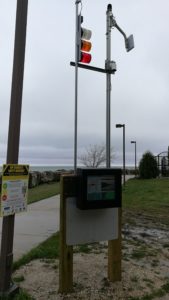Recreational enthusiasts flocking to North Beach on Lake Michigan in Port Washington this summer will be much safer thanks to new real-time “traffic lights” mounted atop an informational kiosk that will brightly indicate the presence, or absence, of dangerous waves and rip currents.

Traffic lights alert beachgoers to dangerous rip currents.
The traffic lights will grab people’s attention, delivering a basic warning. If beachgoers want more details, they can check the kiosk, which is connected to a website known as integrated nowcast-forecast operational system (INFOS). INFOS provides the most current temperature, wind and water conditions, fed with data from a camera at the beach, an underwater sensor and National Weather Service (NWS) reports.
According to the NWS, rip currents kill an average of 12 people on the Great Lakes each year and another 25 people need rescue. The installation of this innovative, effective and real-time warning system addresses those statistics to help save lives. The traffic lights, dubbed beach lights and notifying kiosk—or BLINK—can serve as an alternative to the existing rip current flag warning system, which requires a person to hoist and lower flags. BLINK, with its red for rip currents are present, yellow for conditions are favorable to form rip currents and green for safe conditions, can reduce lifeguard labor and improve the timeliness of condition updates.
Rip currents occur when a strong offshore narrow current forms along sandy beaches as well as around obstructions such as a sandbar, pier or jetty. Water in these areas may sometimes be just knee-high but it can be strong enough to pull a physically fit and otherwise strong swimmer into deeper and more dangerous water. Swimming toward shore while caught in a rip current is like swimming upstream, and a swimmer’s efforts may only lead to fatigue and often little progress to safety.

Yuli Liu has worked with numerous partners to install the safety kiosk.
Yuli Liu, a Ph.D. candidate in civil and environmental engineering at the University of Wisconsin-Madison said, “Sometimes people, when they go to the beach, they don’t have Internet access so they don’t have that source to get the INFOS information. BLINK puts it outside so people can get the most updated information on current conditions to tell if they are safe or they are not safe. BLINK has the dynamic traffic lights to draw people’s attention.”
Liu’s advisor is civil and environmental engineering professor Chin Wu who said, to his knowledge, the use of dynamic light signals in this type of application is innovative and groundbreaking.
Wu further said, “Teamwork and partnerships are the hallmarks of this effort. I’m gratified we can build on the previous NOAA Coastal Storms Program project with the city to now install this new and sustainable system that will provide rip current warning to the public.”
In addition to the city of Port Washington and its Waterfront Safety Committee, he wanted to call out the BLINK partners by name: the Wisconsin Coastal Management Program; We Energies; Wisconsin Sea Grant; National Weather Service, NOAA; and Department of Civil and Environmental Engineering, University of Wisconsin-Madison.
Todd Breiby, program coordinator with the Wisconsin Coastal Management Program, said, “In Wisconsin, we are fortunate to have miles of public access to special coastal places, such as Lake Michigan. We encourage people to go out and experience Lake Michigan as a swimmer or a paddler. Yet, we also want them to be safe. The partners who developed INFOS, and now BLINK, contribute to that love and use of the coasts.”
BLINK holds special importance for Port Washington, where a 15-year-old died in a North Beach rip current in 2012. The community continues to memorialize his loss and the new traffic lights will help prevent future tragedies.
There may be an expansion of the system as well. When installing monitoring equipment at North Beach, Wu’s team also detected dangerous waves at nearby South Beach. That beach is the site of a 2016 death of a 27-year-old kayaker due to dangerous waves.





